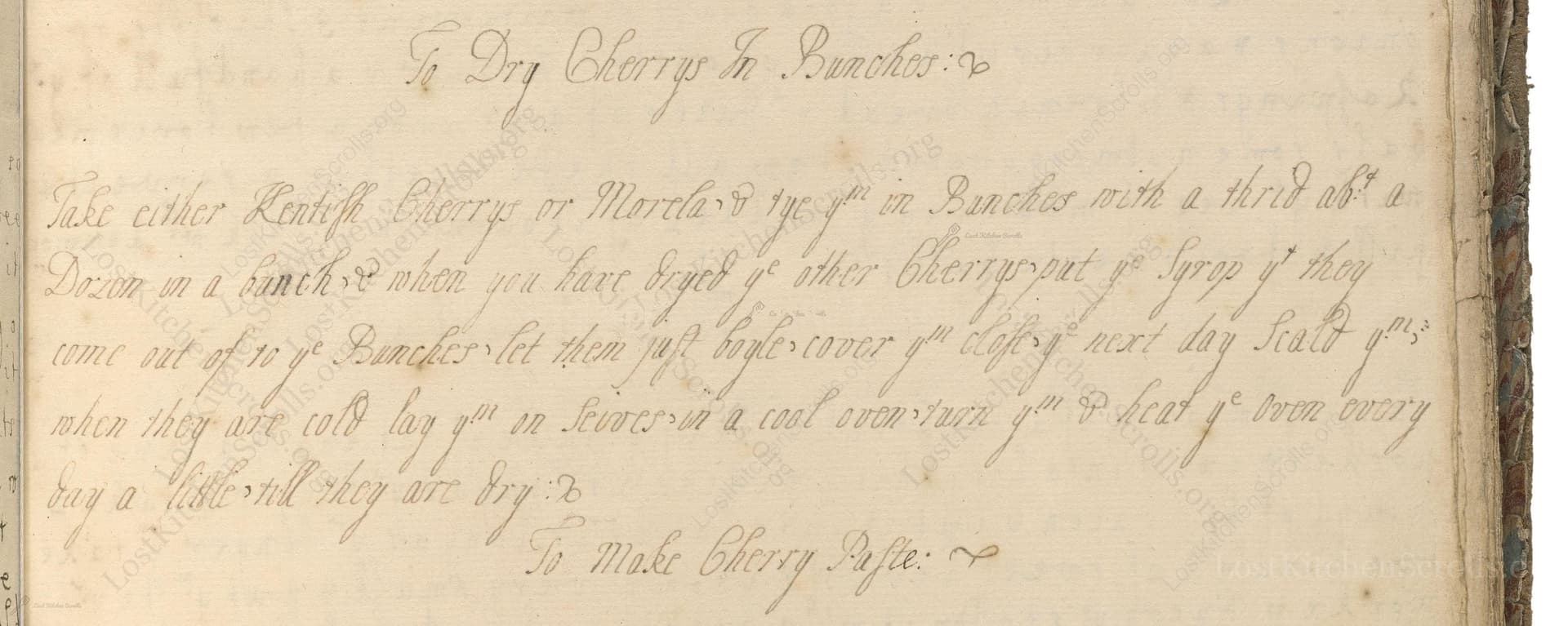To Dry Cherrys In Bunches
From the treasured pages of Cookbook of Mary Puleston
Written by Mary Puleston

To Dry Cherrys In Bunches
"Take either Kentish Cherrys or Morela & tye ym in Bunches with a thrid abt a Dozen in a bunch & when you have dryed ye other Cherrys put ye Syrop yt they come out of to ye Bunches let them just boyle cover ym close. ye next day Scald ym; when they are cold lay ym on Seives in a cool oven turn ym & heat ye oven every day a little till they are dry:"
Note on the Original Text
The recipe is written in typical 18th-century English, with abbreviated words ('ym' for them, 'yt' for that) and nonstandard spelling ('cherrys', 'scald', 'boyle', etc.). The punctuation is sparse, and instructions are given in a continuous flow, assuming an experienced household cook who knows the basics of handling fruit preserves and oven management. Clarifying these terms and breaking the process into precise steps helps the modern reader replicate the results, while staying true to the original technique.

Title
Cookbook of Mary Puleston (1764)
You can also click the book image above to peruse the original tome
Writer
Mary Puleston
Era
1764
Publisher
Unknown
Background
A tantalizing compilation of 18th-century culinary wisdom, this collection artfully preserves the flavors, techniques, and charms of British cookery before 1764—inviting modern gourmets to savor a taste of history with every recipe.
Kindly made available by
Folger Shakespeare Library
This recipe hails from mid-18th century Britain, specifically from the household manuscript of Mary Puleston, who died in 1764. At the time, drying fruit was a common method for preservation before refrigeration—allowing prized produce like cherries to last through the winter. The recipe reflects a time when sugar was becoming more accessible in households, and recipes like this one were as much about display and hospitality as sustenance. Presenting cherries 'in bunches' would have been visually appealing for dessert tables during the Georgian era.

In Mary Puleston’s kitchen, the cherries would have been tied with linen or hemp twine. Sieves or wicker trays served as drying racks, and the 'cool oven' refers to a wood- or coal-fired bread oven, used after the main baking was done and the heat had subsided. A large copper or earthenware pan would have been used to prepare the syrup and scald the cherry bunches. Today, a wire rack or mesh cooling rack in a low oven (set at the lowest possible temperature) serves the same purpose, and twine or butcher’s string is a handy substitute for historical threads.
Prep Time
30 mins
Cook Time
3 hrs
Servings
8
We've done our best to adapt this historical recipe for modern kitchens, but some details may still need refinement. We warmly welcome feedback from fellow cooks and culinary historians — your insights support the entire community!
Ingredients
- 1 lb 5 oz Kentish or Morello cherries (or any tart cherry variety)
- Clean kitchen twine or food-safe string (enough to tie into bunches of 12 cherries)
- 7 oz white sugar (to prepare syrup, if not available from other dried cherries)
- 7 fl oz water (to prepare syrup)
- Optional: substitute sugar syrup if original cherry syrup not available
Instructions
- Begin by selecting either Kentish cherries (a tart English variety) or Morello cherries, both readily available in many markets today.
- Take about 4–5 oz per batch.
- Tie the cherries together in small bunches—about a dozen per bunch—using clean kitchen twine, aiming to mimic the bunching described, or substitute with a food-safe string.
- Once you have dried other cherries (or created a cherry syrup by gently simmering cherries in sugar), reserve the syrup that results from this process.
- Take the prepared cherry bunches and immerse them in the syrup, bringing it just to a gentle boil.
- Cover tightly and leave overnight.
- The next day, heat the bunches gently again (“scalding” them), then allow to cool.
- Lay them on wire racks or mesh sieves, place in a very cool oven (about 120°F), and dry, turning daily and rewarming the oven gently each day, until the cherries are fully dried.
- This gentler, iterative drying process helps preserve the cherries’ shape and intensifies their flavor, echoing the original intent.
Estimated Calories
120 per serving
Cooking Estimates
Preparing and tying the cherries into bunches takes about 30 minutes, while actual cooking and drying steps require around 1 hour each day for 3 days. Drying is slow but not hands-on work. Each serving has about 120 calories, and the recipe makes 8 servings.
As noted above, we have made our best effort to translate and adapt this historical recipe for modern kitchens, taking into account ingredients nowadays, cooking techniques, measurements, and so on. However, historical recipes often contain assumptions that require interpretation.
We'd love for anyone to help improve these adaptations. Community contributions are highly welcome. If you have suggestions, corrections, or cooking tips based on your experience with this recipe, please share them below.
Join the Discussion
Rate This Recipe
Dietary Preference
Main Ingredients

Den Bockfisch In Einer Fleisch Suppen Zu Kochen
This recipe hails from a German manuscript cookbook compiled in 1696, a time whe...

Die Grieß Nudlen Zumachen
This recipe comes from a rather mysterious manuscript cookbook, penned anonymous...

Ein Boudain
This recipe comes from an anonymous German-language manuscript cookbook from 169...

Ein Gesaltzen Citroni
This recipe, dating from 1696, comes from an extensive anonymous German cookbook...
Browse our complete collection of time-honored recipes



